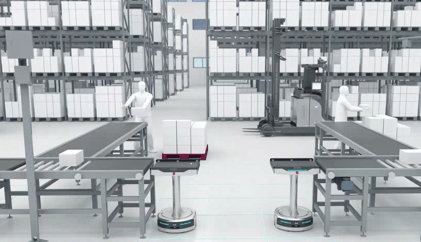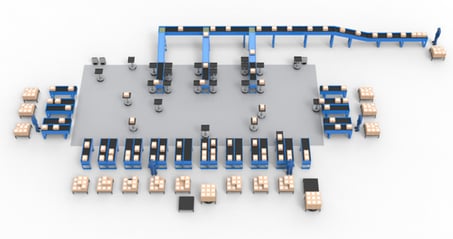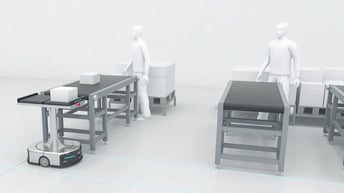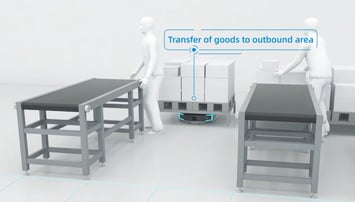The Future of Robotics-enabled Cross-docking
Rising customer expectations for fast and accurate deliveries is one of the most critical challenges for businesses today. While not a new practice, cross-docking has had a resurgence in recent years as it is considered a potential way for getting products from business to customer with minimum damage, time, and cost. But how does it work, what are considered the pain-points of cross-docking and how can technology improve operations?
According to a new study by Transparency Market Research (TMR), the advanced cross-docking services market is expected to grow by 6% CAGR from 2020 to 2030 due to higher requirements for streamlined supply chain operations in industries like food & beverages, pharmaceuticals, and e-commerce. The report also suggests that the growth will depend on future integration of IT and digitalization of the logistics industry.
What is Cross-docking?
Cross-docking takes place in a cross-docking terminal comprised of a receiving dock where suppliers unload inbound goods, a central space where goods are sorted, and an outbound dock where sorted goods are put onto transports which then deliver them directly to the customer. While there are multiple ways of arranging cross-docking, the ones often mentioned are:
Hub & Spoke - providing a central site for items to be sorted, similar items to be combined, and delivered to multiple destinations in the fastest way possible
Consolidation arrangements - combining many smaller loads of items into one method of transportation to save transportation costs
Deconsolidation arrangements - dividing larger loads of items into smaller loads to facilitate the delivery of items to customers
Cross-docking promises many benefits in terms of meeting high customer expectations and lowering costs associated with transportation and inventory handling. However, it’s a complicated process that sets high demands for correct information as well as well-coordinated operations.
Pain-points of cross-docking
Unpredictable demand
Coordination of suppliers, carriers as well as cross-docking terminals are necessary to secure efficient operations. In turn, items characterized by a predictable as well as constant demand has been considered optimal for cross-docking scenarios, while items characterized by unpredictability have been thought of as a risk to operations based on a tight schedule. This is however changing with the application of technologies that can integrate large flows of information to provide more responsive and dynamic operations.
Fast Operations & Human Error
Similarly, promises for highly efficient operations leave very little room for human error and an accelerated need for management. While this might seem like a contradiction, fast and accurate operations can be fulfilled if labor is supported by collaborative systems that enable separation of tasks in the cross-docking terminal, with employees securing the flow of operations while robots do the sorting.
Space & Facility layout
Lastly, challenges associated with cross-docking are, more than anything, issues of space. With little to no room for storing goods as well as a large flow of items, there’s a need for systems that can optimize the use of space and mitigate risks for disruptions caused by unforeseen deliveries jamming systems built on fixed infrastructure.
Evolution of cross-docking
With large quantities of items passing through by the hour, cross-docking terminals must be equipped with systems that can secure accuracy, speed and integrate large flows of information. Geek+ cross-docking FleetSort solution combines sorting and moving robots to help businesses meet challenges in terms of labor, space and the need for fast and continuous operations.
Unloading items
At the receiving dock cartons of inbound goods are put on conveyor belts and automatically transferred onto sorting robots. Geek+ FleetSort solution is highly collaborative and can be combined with material handling equipment like conveyor belts. It supports RFID technology for tracking flows of multiple items and integrates UI visualization for improved sorting accuracy. This reduces the likelihood of sorting errors.

Sorting Items
With multiple activities that need coordination and no storage space, a highly responsive system is necessary for securing timely and continuous operations. The sorting robots will transfer the items from the receiving point to the sorting destination by following a chutes’ layout which is intelligently planned to optimize the use of space. Geek+ RMS – Robot Management System, monitors robot traffic and balances the sorting task of each robot according to demand distribution, which leads to less field usage and optimal sorting efficiency.

Moving items
Lastly, employees will move sorted items from the sorting destination onto pallets. When the pallets are full, employees will use a visual interface to assign moving robots the task of moving pallets of sorted goods to the outbound dock for delivery, securing the final step of fast, accurate and automated cross-docking operations.


What’s Next?
Whether you´re a 3PL seeking to expand your services or a business trying to streamline supply chain operations, the success of cross-docking may depend on the ability to integrate technologies that can enable fast, accurate and collaborative cross-docking operations. Geek+ provides smart logistics solutions applicable to a broad range of supply chain scenarios.
About Geekplus
Geekplus is a global leader in mobile robotics technologies. We develop innovative robotics solutions for order fulfilment. More than 850 global industry leaders use our solutions to realize flexible, reliable, and highly efficient automation for warehouses and supply chain management.
Media Contact
Marie Peterson, VP International Marketing & Communications
Marie.peterson@geekplus.com
